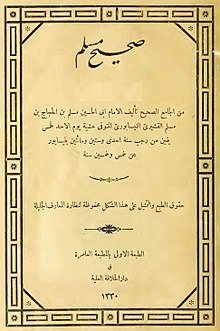
Back صحيح مسلم Arabic صحيح مسلم ARZ Səhihi-Müslim Azerbaijani Сәхих Мөслим Bashkir সহীহ মুসলিম Bengali/Bangla Muslimov Sahih BS Sahih Múslim Catalan سەحیحی موسلیم CKB Sahīh Muslim German Sahih Muslim Esperanto
 | |
| Author | Muslim ibn al-Ḥajjāj (c. 822–875) |
|---|---|
| Language | Arabic, Persian |
| Series | Kutub al-Sittah |
| Genre | Hadith collection |
| Published | 9th century |
| Part of a series on |
| Hadith |
|---|
 |
|
|
Sahih Muslim (Arabic: صحيح مسلم, romanized: Ṣaḥīḥ Muslim) is the second hadith collection of the Six Books of Sunni Islam. Compiled by Islamic scholar Muslim ibn al-Ḥajjāj (d. 875) in the musannaf format, the work is valued by Sunnis, alongside Sahih al-Bukhari, as the most important source for Islamic religion after the Qur'an.
Sahih Muslim contains approximately 5,500 - 7,500 hadith narrations in its introduction and 56 books.[1] Kâtip Çelebi (died 1657) and Siddiq Hasan Khan (died 1890) both counted 7,275 narrations. Muhammad Fuad Abdul Baqi wrote that there are 3,033 narrations without considering repetitions.[2] Mashhur ibn Hasan Al Salman, a student of Al-Albani (died 1999), built upon this number, counting 7,385 total narrations, which, combined with the ten in the introduction, add up to a total of 7,395.[2] Muslim wrote an introduction to his collection of hadith, wherein he clarified the reasoning behind choosing the hadith he chose to include in his Sahih.
- ^ "About - Sahih Muslim - Sunnah.com - Sayings and Teachings of Prophet Muhammad (صلى الله عليه و سلم)". sunnah.com. Retrieved 2022-08-13.
- ^ a b Hadith and the Quran, Encyclopedia of the Quran, Brill